#rus and norse
Explore tagged Tumblr posts
Text
Dragging a Viscount into Early Period
My first hack at more elaborate men's Rus has been prompted by a favorite Viscountess of mine dragging her fighter into early period.
I was given a pile of fabric for pre-determined aspects: a chenille upholstery fabric for the body, a buttery yellow linen for the facings, and a cream linen for the pants. For full disclosure, this piece is a commission that I'm doing at a reduced rate in hopes of getting my name out there on a pretty prominent figure in my region.
I used the calculations for measurements and layout given to me by Dvorianka Anastasiia which are derived from the patterning work done by Mistress Talana the Violet of blessed memory. It is similar to a variation of the style 5 tunic as categorized by The Renaissance Tailor, with trapezoidal gores in both the skirt and armpit, leading to an overall sleeker fit to the body than the standard square armpit gore. As some measurements had changed since Anastasiia last took them, I stressed myself out until I realized I have unlimited power at my fingertips: basic scripting. I wrote a short program to take hard coded measurements and spit out the exact dimensions of the pattern pieces, which felt a little bit like overkill and also not impressive at all.
With pieces patterned, cut out, and (mostly) serged, I delved into construction. I have learned from experience my preferred method of construction is starting by attaching the two body rectangles at the shoulders, attaching and turning the neckhole facing, and then assembling everything flat as follows.

This makes lining up and turning the facing significantly easier for me to do, and hides raw edges within the seams. Starting with the neckhole, however, means there's less fabric for me to fight while I turn a particularly annoying facing.
With the facing laid out on the body fabric, consultation with some of my apprentice siblings determined deep burgundy is the way to go for all the accents. I decided on split stitch around the neckhole and buttonhole stitch around the edges of the neckline, but quickly decided I prefer the split stitch for the rest of the decorative stitching on the garment.

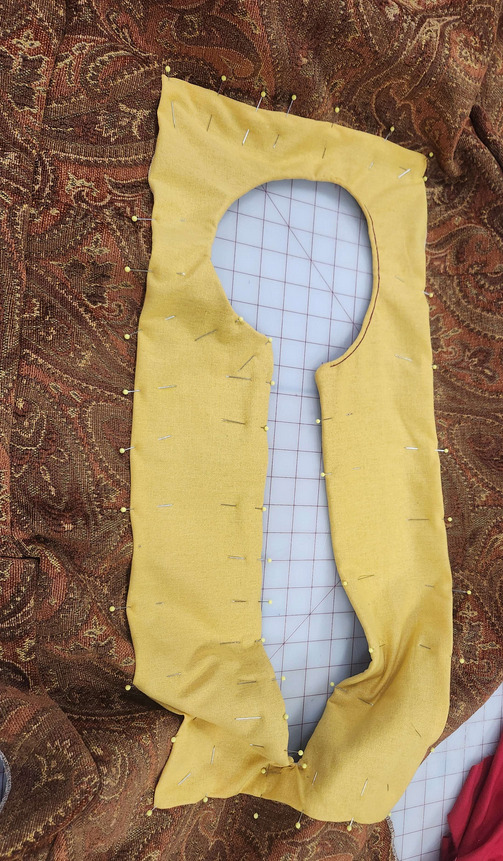
For the sleeve cuffs, I pinned them in place, ran a quick line of running backstitch along the tops of the cuffs to secure them in place, then did split stitch at the top of the cuffs and a running stitch around the opening to keep the edge tidy while still not using visible machine stitching.
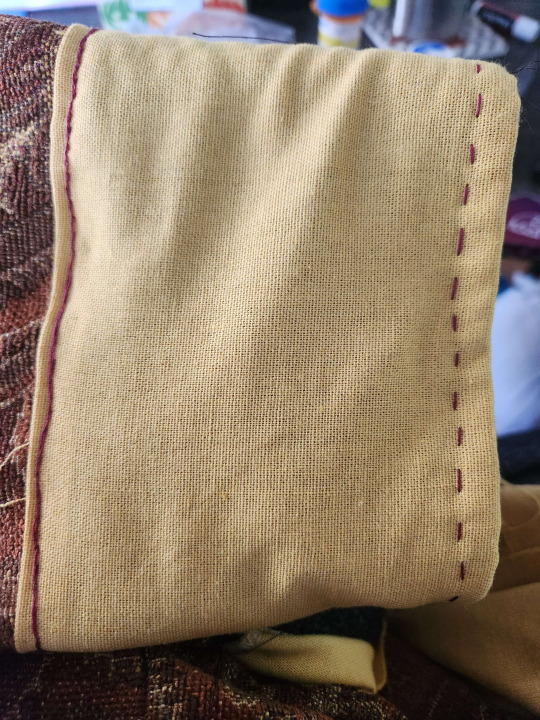
One thing the recipient of this garment expressed is that the striped facing secured with buttons or toggles is an ideal look, and luckily I have a significant quantity of the Vindheim buttons from Bad Baroness in stash. I do not have sufficient woven or braided trim in truly appropriate quantity or style for this garment to be aggressively period, but with the fabric we're already taking liberties and the ribbons look nice and appear to be a popular substitute for strips of silk tape performing the same function in our area. I laid the ribbon out at inch and a half intervals and made sure my lines would be straight on both sides. I turned the ends of the ribbons in and secured them with a whip stitch in a matching thread.
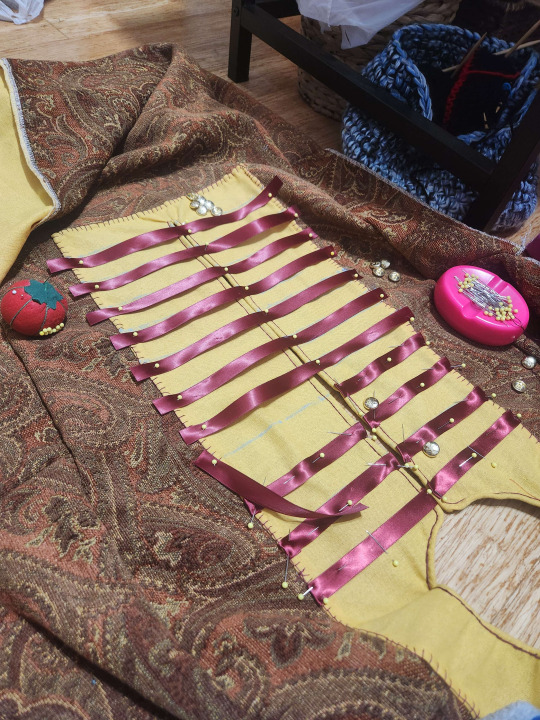
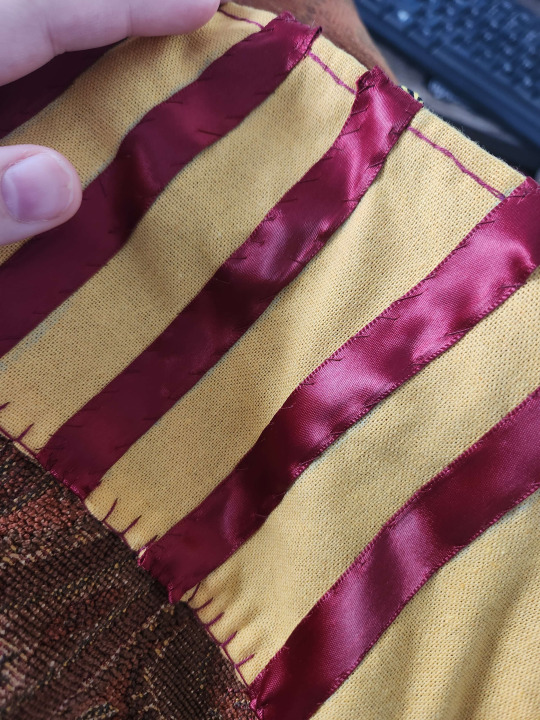
With my facing done and the worst of the neckhole dealt with, I seamed the rest of the garment into an actually clothing-shaped piece of fabric and let it hang for a day while working on other projects.
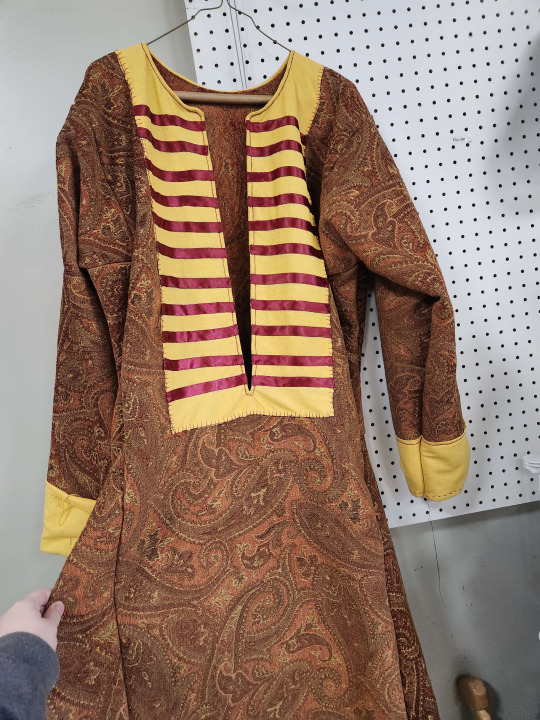
I decided to use a "looped cord" method of button loops, using a cord from an old site token that happens to look an awful lot like the cord used for an award the recipient has received. Starting from the bottom of the neckhole, on the wearer's right side, I've tacked the cord down under the edge of the garment, securing the loops aggressively.
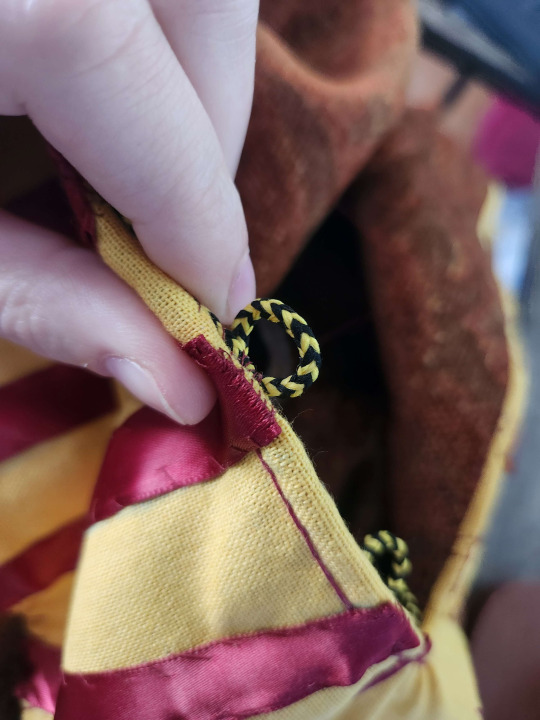
Sometime soon I will get clearer pictures of this garment on the recipient.

The more I look at this garment and all other Rus-ish garments i've made and seen, I think I may need to round the gores into the "skirt" of the tunic more dramatically. I can no longer find the artistic depiction that originally gave me the impression, but until this point i've been letting the right angles of the skirt remain as initially cut, giving an angular overall silhouette but the rounding may be necessary for the right look.
#arts & sciences#a&s#sca#society for creative anachronism#historical costuming#rus costuming#garb#rus and norse#tunics
8 notes
·
View notes
Text

The Invitation of the Varangians: Rurik and his brothers Sineus and Truvor arrive at Ladoga by Viktor Vasnetsov
#viktor vasnetsov#art#varangian#varangians#rurik#sineus#truvor#ladoga#viking age#rus#kievan rus#rurik dynasty#medieval#middle ages#rurikids#history#europe#european#russia#russian#swedish#sweden#norse#nordic#germanic#scandinavian#scandinavia#norsemen#slavic#finnic
135 notes
·
View notes
Text
Hello world! :)
My name is Ru, I am 24 years old (1999) and use they/them pronouns. I am autistic and experience chronic pain.
I am an eclectic witch and love to explore magic with everything possible! I think magic is just so brilliant I couldn't nail down a category for myself if I tried 😂 My favourite thing to do is write original spells and share them with everyone I can, as well as create tarot spreads in the moment when doing a reading with my deck. I hope to share both of these things with all of you here 🥰
I am a Lokean and have been since 2018! If you ever followed a blog called "Loki'sCinnamon", that was me. Sadly, when trying to delete a side blog I no longer used, I accidentally deleted my main blog. In an instant I lost the last two+ years of my record with Loki, all of my original craft work, and connections with all the mutuals I had formed. I was devastated, and didn't feel ready to come back to tumblr again for a long time.
I think I am ready to start again now.
Sometimes the chaos of a forest fire makes way for the growth of new trees, after all 🌿
Currently I am just working with Loki as to not overwhelm myself, but I have also worked with: Odin, Hel, Thor, Hades and Persephone!
I would truly love to use this blog to get back into the world I once had here and make connections with people who also practice witchcraft and know Loki is so much more than the negative stereotypes that closed minded people shrink them to.
Please feel free to send me a message if you pick up on some good vibes (I met someone who I consider family to me back in 2018 right here through a Loki connection! 🥰), as making friends as a ND adult can be very hard, I will do my best to reply!
Or: please submit an ask if you would like a free tarot reading or a free original spell creation based on your request :)
I want to put my skills to good use and make connections, feel free to request from your blog or anonymously and sign off with an emoji, I don't mind which works best for you at all 🥳🖤🩷💚💙
#ru rambles#ru readings#lokideity#tarot#paganblr#paganism#paganlife#pagans of tumblr#pendulum divination#pendulum readings#eclectic witch#norse pagan witch#norse witch#pagan witch#tarot witch#witch community#witchblr#witchcraft#loki deity#lokean#loki devotee#loki devotion#norse loki#free tarot#tarot cards#tarot reading#tarotblr#tarotcommunity
12 notes
·
View notes
Text
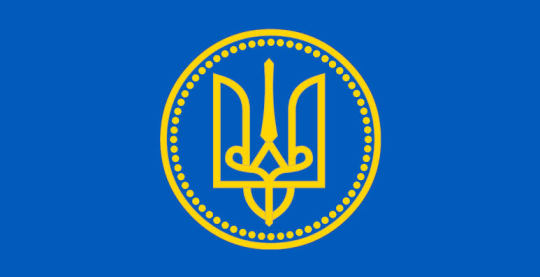
Timeline of the Rus' Empire (alternate history)
1000- The Rus' Empire starts as an Eastern and Orthodox Christian fragment of the Viking Empire split under the Treaty of Novgorod. The Emperor installed is Vladimir the Great who rules until 1015.
1015- The Rus' Empire conquers Azerbaijan, thus making it part of Caspian Rus' (Kaspiya) along with Kaukasiya (Dagestan). Ingvar the Far-Travelled is the governor of Kaspiya. But invasions of Persia fail.
1050- Kaspiya Province falls to the Seljuk Turks under Tughril.
1074- After several failed attempts, the Rus' finally conquer Pecheneg lands and assert dominion over Crimea.
1140s- Emperor Vsevolod II incorporates Uralic tribes into the Rus' Empire.
1223- The first Mongol invasion of the Rus' Empire ends in the Mongols conquering a huge swath of Pontic-Caspian steppe.
1237-1240- Under Batu Khan, the Mongols launch successful conquests of the several cities in the Rus' Empire. Which lead to the siege of Kiev in 1240, thus ending the Empire.
1240- Independent states in the Far North of the Rus' such as The Karelian Republic and Varangian Commonwealth form.
#history#alternate history#slavic#nordic#norse#scandinavian#viking#kievan rus#novgorodian rus#turkic#mongols#russia#ukraine#belarus#varangian#baltic#geography#alternate geography#driphans althistory
3 notes
·
View notes
Text
I love that with a couple asterisks, you can say "Vikings VS. Romans with flamethrowers" is a historical matchup that actually happened
#the asterisks are as follows#its the byzantines so still the roman empire (fight me) but a thousand years of cultural development removed from the romans you imagined#Its the Rus so like... slavic-norse culture from the area thats now Ukraine and russia and that general area#and flamethrowers are greek fire. I'm sure we all know everyone's favorite brand of medieval napalm#anyway ain't history neat?#history#romans#roman empire#byzantine empire#byzantium#vikings#greek fire
2 notes
·
View notes
Text
ah… wait. augh. things to add to the Rohan Siblings Fic
#decorative embroidery wasn��t suuuuper common w viking-age Norse but they did adopt it after Saxon + Rus influence#they were generally decorative collars/cuffs done with linen thread which decays easily in graves#anyhow. Éowyn embroidering Théodred’s tunics for him#some of her first ‘serious’ embroidery practice being decorating his collars/cuffs
0 notes
Text
are you stuck trying to decode the book of bill but you don’t want the keys handed to you? i was in your shoes literally three days ago! i failed and looked up codes on reddit (because a good grade in book of bill is a normal thing to want and a possible thing to get) but now you don’t have to!! here are some BOOK OF BILL CODEBREAKING HINTS designed to kindly shove you in the right direction!
my credentials are: one summer cryptography class i took in high school, autism, weirdly good pattern recognition (probably because of the autism), and a desperate need to make things make sense. sorry in advance if any of this seems patronizing. hints below the page break!!
general tips:
- A and I will become your bestest friends. like 99 times out of 100 any single letter is a or i. try those out first
- the apostrophe will also become your bestest friend- especially x’x, which will almost always be i’m (except there’s one place in the book where it is not. don’t make my mistakes.)
- themysteryofgravityfalls.com is SO so helpful. for non-symbolic ciphers u can lowkey put in codes and button mash caesar and atbash. godsend. devilsend? idk someone sent it and it’s wonderful
- call every phone number, visit every website. they bought those domains for a reason! i think!
- any list of numbers 1-26 is a1z26. like that’s simply a truth
cipher specific hints now !!!
RUNES (characters taken from norse runes)
- there is a key for this one in the book! maybe u spotted it right away but i did not lol, so look for an instance of 26 rune-y characters!
- the rune code on the inside cover is a graffiti joke- translates to a common thing people write on walls or carve into books made out of brain matter ig
THERAPESE (found in the last few pages during bills court-ordered therapy)
- bill’s picture is labeled in this section, so those characters translate directly to “bill cipher” ! once you have those, you can apply them to other instances of the code and go from there
- the rest of the names of the… things around him on the inpatients page are puns, titles, and/or weird words. they might look wrong until you have Every Character- trust ur key! use the rest of the instances of this code to find the missing letters first, make sense of it and laugh at the clever little joke later
BROSCODE (only two instances, found in journal 3 lost pages)
- the name is a hint by itself- this is stanley and stanford related! both stans use it once somewhere in the book!
NEWBILL (the most common symbolic cipher in the book)
- if you have journal three, the characters are VERY similar to a code there- not the same though, so don’t try and use that key. but like journal three, this code will (almost) always be bill speaking.
- ok lowkey i think the best way to explain this is just to give you one answer. i cracked this by randomly guessing that the small writing by the galaxy drawing on the journal three page “a voice form the past” translates to “forget the past”. go from there my loves
- that being said. everything else from journal three uses the same characters, but a different code. haven’t cracked it yet. looking for advice tee bee haych. i’ll edit this once i find it out
- also: dipper uses this code in his section. that’s pretty helpful to get most of the rest of the characters!
now some page specific hints!:
silly straw page. Oh god
- damn that themysteryofgravityfallsdotcom sure is helpful! Anyway,
- the numbers code is Weird. but the number don’t equal letters. notice the spaces between number groups- pair the groups, try and add a dash somewhere within the first group and a colon somewhere within the second group. you’ll have to use your resources a little
- if that made zero sense: “uhvrxufhv” phdqv brxu idyrulwh ghhsob ohjdo wy vkrz ylhzlqj zhevlwh. ru brxu kxox dffrxqw
- sorry for the vagueness but i really don’t want to spoil this one- i got it spoiled but i think figuring it out on your own would be really rewarding and worth your Time
messages on your tv
- there are strange boxes on the bottom of the page. gonna be so honest don’t know how they mean anything at all to anyone but allegedly it’s a code! i’ll look into it. idk man
okay. i think that’s all i’ve got? please comment if u have questions for me or other folks on here or suggestions on how to sound less like a fucking nerd talking abt this shit. idk i love that people are set on cracking this book asap but i hope this helps ppl who prefer The Thrill Of The Chase and also like to feel smart and important and so very talented
#get a load of this guy!#sorry ik this must sound so pretentious. unfortunately my cryptography hyperfix is BACK#but also#normalize using codes and ciphers as set storytelling devices. big book of bill fan but why do bill and ford use the same code#the book of bill#book of bill#the book of bill spoilers#book of bill spoilers#bill cipher#code breaking#book of bill codes#ciphers#arg#like technically#shutupmac#codebreaking help
107 notes
·
View notes
Photo

Birka
Birka, located on the island of Björkö in present-day Sweden, was an important trading center and strongly fortified town in the Viking Age which flourished from the 8th through the 10th centuries CE. Along with the town of Hedeby which is located in present-day Denmark, Birka was the most important Viking trading center in Europe. Due to its prime location on Lake Mälaren, which provided sailing access to the Baltic Sea through the Södertälje Canal, Birka attained great wealth as a mercantile settlement and entrepôt with extensive trading ties to Western Europe, Scandinavia, the Slavic and Byzantine east, as well as the Arab World. Birka was also the location where the Frankish missionary St. Ansgar (801-865 CE) first introduced the Swedes to Christianity c. 829-831 CE. UNESCO recognized Birka's importance in early medieval European history, declaring its archaeological site a World Heritage Site in 1993 CE, together with the neighboring site of Hovgården on the island of Adelsö.
Geography & Early History
Birka is located on the Swedish island of Björkö, which sits about 35 km (22 miles) to the southwest of the Viking town Sigtuna and 30 km (19 miles) west of Stockholm. In the Viking Age (c. 790-1100 CE), Lake Mälaren functioned as a bay adjacent to the Baltic Sea, and Birka was thus perfectly positioned near the northern long-distance trade routes that ran between the British Isles, Western Europe, the Kievan Rus, the Byzantine Empire, and the Abbasid Caliphate.
Although Danish and Norwegian Vikings sailed westwards towards the British Isles, Iceland, and Western Europe from the 8th-11th centuries CE, Swedish Vikings sailed eastwards, trading and raiding their neighbors in what is present-day Finland and Estonia as well as the Slavic Wends who inhabited what is now present-day eastern Germany. By the 800s CE, Swedish Vikings had managed to navigate their ships through the rivers of what is now Russia and Ukraine, penetrating as far as the Byzantine Empire and Abbasid Caliphate via the Dnieper, Don, and Volga Rivers. They brought back furs, silks, iron artifacts, and other luxury goods to Birka, which they then sold to merchants from Hedeby and Western Europe. The wealth that traversed the Baltic Sea also helped encourage Birka's founding at some point between c. 750-800 CE. As one of the earliest Viking trading hubs and one which generated (and, in turn, spread) tremendous wealth, Birka can be viewed as a catalyst for social and economic development in Scandinavia and Eastern Europe, becoming part of a larger network of trading centers which sprung up across the region.
There had been an earlier trading center on the island of Helgö, which is located about 8 km (5 miles) to Birka's southeast, and it is probable that both Helgö and the area in and around Birka became inhabited sometime around c. 400 CE. The name “Birka” might mean "marketplace" or "place of commerce", although its location on the island of Björkö ("birch island") fosters the idea of a connection with the Old Norse word bjǫrk, meaning "birch tree". It is likely that the Swedish kings who ruled from the nearby island of Adelsö – this is where the royal residence of Hovgården was located – oversaw or took some part in Birka's founding and the organization of economic activities on the island of Björkö. Birka, located in proximity to the royal court, was protected by royal charters as the town greatly enriched royal and noble coffers.
Continue reading...
28 notes
·
View notes
Text
You know what I'd like? I'd like a Chinese fantasy show - standard historical fantasy sort of thing - about a group of martial artists/cultivators being sent on a journey to the utter West. Following some sort of prophecy or something.
Of they go, fast forward, they get as far as Constantinople at the height of its power (history? accuracy? bah!), and our intrepid group of cultivators run afoul of a group of Varangians (surprise co-production with Scandinavia y/y?). Not as in sworn enemies, just - they keep accidentally crossing paths in unfortunate ways, keep having cultural misunderstandings, and occasionally end up hanging out just because.
Both groups are hanging out at the same inn - and either somebody's singing a mournful song of home, prompting questions of "where did you hear our prophecy?", or somebody's reciting the prophecy, prompting "when did you ever visit Iceland?"
So, yeah, long story short the Varangians - who were about to head home anyway - agree to act as escorts/guides to our intrepid cultivators, who for mystical reasons need to get to Hekla.
Off the show goes, along the rivers through Rus to Scandinavia and then further North, beneath the Northern Lights to Iceland.
Of course, this is a artistic license fantasy show - so our Varangian/Norse friends? Turn out to have their own magic powers. Saga style magic powers. Maybe somebody gets replaced by a bear whenever he falls asleep. Maybe somebody's mother was a troll. That sort. And the Northern Europe of this show is definitely fantastic - there's probably a sea serpent somewhere.
They get to Iceland, they do whatever needs doing - turns out, our intrepid cultivators now need to rush home to finish the magic whatever back in China.
And, of course, now they and the Norse have bonded, especially one of the cultivators and one of the Norse (handsome fellows, naturally), and so of course their escort have to go escort them right back (besides, if there's really a city more glorious than Miklagard, they need to go see for themselves).
So, back to fantasy China we go...
682 notes
·
View notes
Note
what are your asoiaf culture/race headcanons?
ooo im siberian starks truther forever, or just general indigenous arctic circle north. general aesthetics of slav/kievan rus. like kokoshnik ushanka and ryasna are canon to me. harsh, stilted syllables like in russian.
the riverlands is the balkans + ireland to me for sure, cat is so irish to me. i think of like south slav folk costume for them :) lots of ribbons and embroidery and intricate braiding. lilting accent
i like east asian targs :) but also like, they just arent any earthen race to me. hate when people are like "erm they cant be coloured cos they have purple eyes and silver hair?" and its like do white people have purple eyes and silver hair??????
the dornish are a mix of indian subcontinent+west asia+sephardic/mizrahi jewish+palestine+turkish+arab. the melting pot of westeros! like the daynes are jewish to me, and the rhoynar are arab/turk/'moorish'. yronwoods are white latines. sea of dorne/narrow sea evokes the mediterannean :) dornish is described as melodic and drawling, def lots of rolled Rs
stormlands is very german+eastern europe. maybe im jsut thinking of oktoberfest but i always think of them bundled up. lots of headdresses. harsh accent.
vale of arryn is very anglo to me. french/english/swiss/etc. yodelling on the mountains. sweet and sing-song accent.
westerlands is italy to me cos i like thinking of the borgias and lannisters. lannisport gives off SUCH florence/venice vibes.
the reach is again quite meditteranean to me. maybe its the wine? but i hc the tyrells as black, i think the dynamic of "upjumped stewards" compared to the "blue-blooded" hightowers, florents, etc is interesting. its why i also hc the manderlys as black, since they're from the reach :)
iron islands... obviously norse/viking, but i like pasifika headcanons too. i like asha with moko kauae and i just love if the ironborn have cultural tattooing practices. this is lessened by how they do not at all have a pacific climate lol.
80 notes
·
View notes
Note
I am watching a video with criticism of geographical determinism in worldbuilding and realized that I don't really remember seeing any fictional stereotypic merchant state that relies on rivers.
Norse and Rus were whom I had in mind, but to my knowledge British and Japanese people also heavily utilized rivers for trade and I would be very surprised if Ancient Chinese people didn't.
I don't know about history of First Nations of North America and did they have trade in our understanding, but I heard that river system of North America is so convenient that the entire 19th century demand for transportation could have been covered by it alone, without trains.
Just some ideas
Freshwater systems are woefully underused in worldbuilding. The other day I was reading about the history of my region and I was amazed at how big and sophisticated native canoes were in the Paraná, the Paraguay and the Amazonas, and how virtually nobody talks about it. We are talking about ships that could hold about 30 people and some were bigger than Columbus caravels. For centuries into the colonial era, the Spanish and Portuguese hired or pressed into service native navigators for the rivers which were though to navigate as a sea. Still before that, they were the major arteries of commerce and trade through the continent, this is well known. Even Patagonian goods are reported in Corrientes (North of Argentina) which indicates that trade there got very far. As for the Chinese, not only rivers were important to the but also they boasted an amazing canal system but that's about all I know.
One thing I learned recently about rivers and cities is that cities were often founded on the side of rivers, yes, but almost never at their mouth. Look for example at Paris, Rome, London, the Egyptian capitals. They were founded by the river, but the mouth of the river next to the sea is where the delta is, and deltas always change and flood, carrying mud and slit, they aren't good places to build at all. Good river cities are built in the 'deep side' of the river where you can build ports, not in the side where sediment accumulates. Another issue with river cities are marshlands. For example, I remember reading that the marshlands of ancient Rome were drained at great cost. Ancient peoples knew that marshes were 'unsanitary' even if they didn't know why (it's because they host mosquitos and parasites, not because of anything bad wetlands have on itself) and they had to deal with them. There are some exceptions to this, like Venice which was basically built on a marshland (or the Netherlands).
And indeed rivers were (and still are! I see ships going up and down the Paraná every weekend!) a very efficient way of transportation. There's lots about it written in Europe, but river barges were basically the railroads of their time. Before the advent of railroads, people in Europe (and China) weren't thinking roads, but canals, the French built a lot of canals at great expense which became obsolete later by railroad.
Unfortunately the sources about river canoes and transportation in America (continent) are often tucked away in papers and history books, there really isn't that much accessible literature and illustrations about it. Which is a goddamn shame because learning about native canoes bigger than Spanish caravels (and they were still building them in Paraguay and Argentina during colonial times, according to my sources) blew my mind.
71 notes
·
View notes
Text
As modern science and better archeology methods reexamine historical sites more of women’s history will emerge
by Sarah Durn September 27, 2021

The National Museum of Stockholm's Ride of the Valkyries was painted during the Victorian period, which saw renewed interest in Vikings. Fine Art Images / Heritage Images / Getty Images
In Atlas Obscura’s Q&A series She Was There, we talk to female scholars who are writing long-forgotten women back into history.
In 1871 on the sleepy island of Birka, Sweden, Hjalmar Stolpe, a Swedish entomologist turned archaeologist, discovered the lavish grave of a Viking warrior. Around the seated body were the remains of two sacrificed horses, as well as a double-edged sword, a scramasax (a long, thin knife), a bow, a shield, and a spear—every weapon known to the Viking world. It was an astonishing find, especially since Viking warrior graves rarely contain more than three weapons. There was also a full set of hnefatafl, the board game often known as Viking chess, which indicates the strategic thinking and authority of a war leader. A thousand years ago, the site would’ve abutted the Warrior’s Hall, where a garrison lived to protect the bustling Viking town of Birka. The weapons, game pieces, location: Everything told scholars that the man buried in what is known as grave Bj 581 was a prominent, well-respected Viking warrior. No one was really prepared when DNA tests were conducted in 2017 and a new story began to emerge. This was a prominent warrior, all right, but the occupant of Bj 581 wasn’t a man. She was a woman.

Viking historian Nancy Marie Brown’s new book, The Real Valkyrie: The Hidden History of Viking Warrior Women, explores what life might have been like for the warrior woman of Bj 581.
Using more evidence from the recent tests conducted on the remains, Brown traces her journey from Norway to the British Isles to Kiev then, finally, to Birka. Brown imagines the unnamed warrior meeting other prominent Viking women, such as Gunnhild, Mother of Kings, or Queen Olga, ruler of the Rus Vikings in Kiev. She also explores the Viking sagas and contemporary sources with a new lens.
How did you initially get interested in Vikings—and female Vikings in particular?
When I went to college, I actually wanted to study fantasy writing and, you know, learn to write like Tolkien. I learned very quickly that that was not appropriate for an English major in the 1970s, so I decided to study what Tolkien studied, and he was a professor at Oxford University, teaching Old English and Old Norse. So I started reading all of the Icelandic sagas that I could find in translation. And when I ran out of the English versions, I learned Old Norse so that I could read the rest of them.
One of the things I liked about [the sagas] the most was that they had really interesting women characters. There’s a queen in Norway who appears in about 11 sagas, Queen Gunnhild, Mother of Kings. She led armies. She devised war strategy. And then I was looking at the valkyries and the shieldmaids and thinking, you know, these are really interesting people that have always been considered to be mythological.
So when I learned in 2017 that one of the most famous Viking warrior burials turned out to be the burial of a woman, that just absolutely dazzled my imagination.
Is this the first confirmed grave of a female warrior that we have?
This is the one that has the best proof. There are one or two others that have since been DNA tested and proven to be female. But in each of these cases, it’s hard to say if the person in the grave, whether male or female, actually was a warrior, or if the object that we are interpreting as a weapon was used for hunting or for some other purpose.
In this case, it’s every Viking weapon known to history. So it’s such a clear result. And the DNA was so completely female.

When Stolpe discovered the Viking gravesite Bj 581 in 1887, he assumed the remains were of a man. That assumption was shown to be wrong 140 years later. Rapp Halour / Alamy Stock Photo
What do we know about the life of the Viking warrior woman in Bj 581?
In 2017, by testing her bones and her teeth, [scholars] could say she was between 30 and 40 years old when she died. They could also tell that she ate well all of her life. So she came from a rich family or maybe even a royal one. She was also quite tall, about 5’7”. By the minerals in her inner teeth, [scholars can determine] she may have come from southern Sweden or Norway, and also that she went west maybe as far as the British Isles before her molars finished forming. She didn’t arrive in Birka until she was 16.
We also have her weapons and a little bit of clothing that were found in the grave. And these link her to what is known as the Vikings’ East Way, which was the trade route from Sweden to the Silk Road.
We can link, through the artifacts and through the bones, that she could have traveled from as far west as Dublin to as far east as at least Kiev in the 30 to 40 years of her life.
How do we know that there were Viking warrior women?
They are mentioned many, many, many times in the literature. In most cases, they have been dismissed as mythological because, of course, we know warriors were men. But we don’t know that. That is an assumption that is based on traditional Victorian ideas that because women are mothers, they’re nurturing, they’re peacemakers, and they don’t fight.
That’s not historically true. Women have always fought. And they appear in most cultures until the 1800s, when Viking studies and archaeology pretty much started. So we sort of have this problem of bias in our earliest textbooks.
But now we have actual scientific proof of one warrior woman in the Viking Age. And as the scientists who did the study say they would be very surprised if she was the only one.
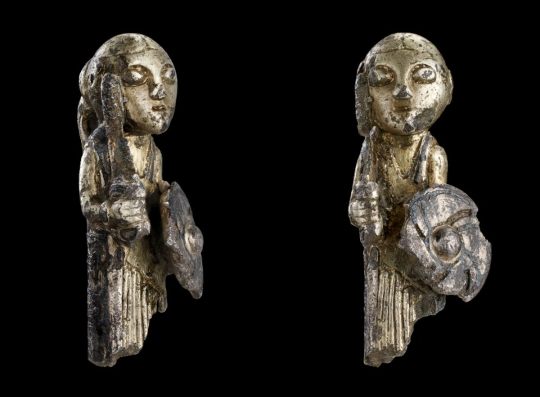
This small female Viking warrior figurine discovered in Harby, Denmark, has been interpreted as a mythological valkyrie. John Lee / National Museum of Denmark
There’s this assumption that the warrior men of myth must have been based on real people, but it’s not the same for the mythical warrior women. Why is that?
It’s just an assumption based on what people think women are like. Most of the material we have from the Middle Ages was written by men, and most of the material we have until the 1950s was written by men, and women are slowly making their way into the field of Viking scholarship. But many of them are still working under the assumptions that they were taught.
I noticed when I went back and reread some of the sagas in Icelandic that there wasn’t this clear distinction between the warrior women being mythological and the warrior men being human. When you actually look at the old Norse text, there’s a lot of words that have been translated as “men” that actually mean “people,” but it’s always been translated as “men” because it’s a warrior situation.
If you’re translating, you have to make decisions and sometimes your decisions have repercussions that you don’t expect, like writing women out of the history.

By the time Hjalmar Stolpe excavated Bj 581, he had become adept at recognizing where graves could be found in the hummocky Birka landscape. WS Collection / Alamy Stock Photo
Is it possible for historians to remove all of those biases?
No, I don’t think it is. I think we all are looking through our own lenses. But we have to revisit those sources every generation to see past biases. So when you have layer after layer after layer of removing biases, you may get closer to the truth.
What most surprised you in the course of researching your book?
One of the controversies right now in Viking studies is should we really be talking about men and women at all? Maybe there were all kinds of different genders. We don’t know if there were more than two genders in the Viking age. Maybe it was a spectrum.
If you look at this one group of sagas called the Sagas of Ancient Times that are often overlooked because they have all these fabulous creatures in them, like dragons and warrior women. It’s really interesting [because] these girls grow up wanting to be warriors. They’re constantly disobeying and trying to run off and join Viking bands. But when they do run off and join the Viking band, or, in another case, become the king of a town, they insist on being called by a male name and use male pronouns.
So it was very shocking to me to go back and read it in the original and say, “Wow, all this richness was lost in the translation.”
#Nancy Marie Brown#The Real Valkyrie#Books by women#Books about women#Atlas Obscura#She Was There#Sweden#Birka#grave Bj 581#Warrior women#Vikings’ East Way
25 notes
·
View notes
Text
Steal something from me!
Tagged by @teamdilf who's cat tree I'm gleefully appropriating for Grim and Mims to climb, aaaand I'm gonna tag back @teamdilf plus @sparatus @korblez @omniblades-and-stars @kayarenwick @ferowyn @aceouttatime
5 notes
·
View notes
Text

Today I wore this beautiful pin in honor of Loki 🕷💜
#loki deity#lokideity#paganism#paganblr#paganlife#norse pagan witch#norse witch#norse deities#lokean#loki devotee#norse loki#deity offerings#ru rambles
9 notes
·
View notes
Text

A couple of my recent followers on their own blogs mentioned a viking au for bnha.. and my history nerd took over. Admittedly this is more Rus than norse, but the caftan looked better for his coat.
22 notes
·
View notes
Text
Crossposting from Twxttxr: some interesting news about ongoing research by colleagues, from a workshop "Diversification of Uralic" just this Thursday and Friday
Do the Permic languages have loanwords from Old Norse? e.g. ONo. ár ~ Komi & Udmurt ar 'year'. This would've been sensible during the brief time when Norsemen originally from Sweden were in charge of trade along the Volga and settling in inner Russia, forming the Rus' (later Slavicized, but as we know from Byzantine sources they remained Norse for centuries) — and also the Norwegians too were known to conduct exploration + trade along the Barents Sea at the time, our oldest written reports of "Bjarmia" come from them after all.
Do the Finnic languages have loanwords already from Pre-Proto-Germanic into Pre-Proto-Finnic? My first reply would've been "yes surely", this has been discussed for half a century and there's dozens of etymologies out by now. Turns out though that there's still a lot of room for skepticism if we try to assemble a big picture. Most of these could be (and have been proposed by other analyses) to be proper Germanic after all, or from some non-Germanic kind of Indo-European, or even incorrect. There is unambiguous evidence I think at least of loans lacking *ā > *ō, but that's already though to be one of the latest common Germanic innovations, perhaps barely post-PG. [Follow-up question: do we even know where Pre-Proto-Germanic was spoken? might not have been anywhere convenient for contacts with Pre-Proto-Finnic.] — A few similar problems also in the less discussed supposed layer of Proto-Balto-Slavic or pre-BSl. loans, but by areal considerations it seems obvious to me there must've been Uralic/IE contact somewhere in the Russian forest belt for ages already, even if it might not have left enough evidence to clearly distinguish from things like pre-Indo-Iranian loans.
Do the Samic languages have loanwords that are not from any historically attested branch of Scandinavian, but some sort of a lost variety entirely? This could be an explanation for an unexpected sound correspondence *j → *ć in many loans; it might also explain some loans that look surprizingly archaic, e.g. lacking any reflection of Siever's Law. One example showing both is indeed *Tāńćə 'Norse', from some sort of a *Danji- variant of Proto-Germanic *Daniz.
Several new hypotheses on the history of of sibilants in Ugric, adding to the growing tally of evidence that traditionally reconstructed *s > *θ and *ś > *s "in Proto-Ugric" are actually later developments. A paper supposed to be coming out soon!
No linguistic evidence so far, but a 1670 travelogue by de La Martinière appears to still report seemingly pre-Uralic populations along the Barents Sea coast — and even on Novaya Zemlya, traditionally thought to have been uninhabited (as reported by other early modern explorers) before some Tundra Nenets briefly settled there in mid 19th century. Apparently there's been no real archeological investigation, but also at least two stone labyrinths are known as signs that humans still must've at least visited there sometime in the past. [By current knowledge, labyrinths from Sweden and Finland have mostly been built in late medieval and early modern times though, so they don't suggest especial antiquity either. Could the ones on NZ in fact have been left behind by some of these historical Northwest European expeditions?]
Various discussion also on the development of Samoyedic. Nothing particularly all-new (maybe on Nganasan, more on that in a PhD thesis to appear later this year though), but a few main results include 1. clear recognition that there is no "North Samoyedic" group (as has been suspected for several years now), 2. confirmation that there is regardless a narrower Nenets–Enets group, and 3. some development of a model where all three of Nenets, Enets and Nganasan may have moved to the tundra zone independently from further down south (as is certainly the case for Northern Selkup, the most recent northern expansion of Samoyedic speakers).
#historical linguistics#loanwords#language contact#archeology#ethnohistory#uralic#finnic#samic#permic#samoyedic#germanic
31 notes
·
View notes